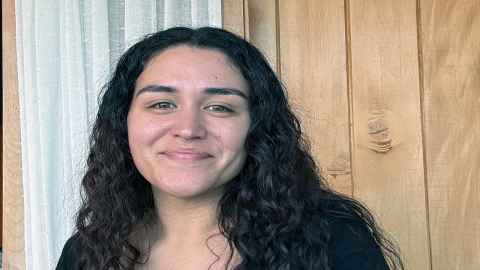Celebrate Te Vaiaho o te Gagana Tokelau - Tokelau Language Week 26 Oct - 1 Nov
24 October 2025
‘Tokelau, Puaki mai ko tau aganuku mo fanau i te lumanaki - Tokelau, Unleash your culture for future generations’.

Masters graduate Mia-Mae Taitimu-Stevens (Te Rarawa/Aotearoa, Togafuafua, Vaito'omuli/Sāmoa, Fakaofo/Tokelau) is the Māori and Pacific Academic Engagement Adviser for Te Tumu Herenga | Libraries and Learning Services | Student and Scholarly Services. She’s also Chair of the Women of Colour Staff Network at Waipapa Taumata Rau, University of Auckland.
She says her research journey at the University has been shaped by a personal quest to reconnect with her Pacific and Māori whakapapa after growing up feeling disconnected. This year’s theme for Tokelau Language Week, ‘Tokelau, Puaki mai ko tau aganuku mo fanau i te lumanaki - Tokelau, Unleash your culture for future generations’ strikes a chord with Taitimu-Stevens. It means navigating and exploring her connection to Fakaofo, through her paternal great-grandmother Akenese Taiua Meleisea, nee Pereira, with confidence.
My journey of exploring cultural identity directly shaped my research path. Growing up disconnected from both my Pacific and Māori whakapapa, University became the space where I was simultaneously (re)learning who my people are and who I am.

“My journey of exploring cultural identity directly shaped my research path. Growing up disconnected from both my Pacific and Māori whakapapa, University became the space where I was simultaneously (re)learning who my people are and who I am.
“I was especially drawn to the study of essentialism; the idea that there’s only one way to be Sāmoan, Tokelauan, or Māori.”
The realisation that she didn’t fit the many narrow expectations of colonial narratives reignited a passion of exploration and critique of the essentialism of Indigenous and Pacific wāhine, focusing particularly on body markings such as moko kauae.
She graduated with First Class Honours in a Master of Indigenous Studies last year in September. Her dissertation, Moko Kauae Online: Social Media as a Tool of Resurgence for Young Māori Wahine Receiving Moko Kauae, explores the evolving perceptions of moko kauae eligibility through the lens of TikTok and digital discourse.
“Moko kauae has always been a topic close to my heart,” says Taitimu-Stevens. “It helped me interrogate my own journey with identity security as a wāhine Māori.”
Taitimu-Stevens quoted poet and novelist Rainer Maria Rilke in his poem Go to the Limits of Your Longing emphasising resilience; an invitation to embrace the full spectrum of human experience—joy and suffering alike—without resistance, a reminder that emotions are transient and transformation is inevitable.
Let everything happen to you
Beauty and terror
Just keep going
No feeling is final
Rainer Maria Rilke
With her ancestral ties to Tokelau continuing to shape and influence her worldview, Taitimu-Stevens continues to inspire through her commitment to Indigenous scholarship and community engagement.
Fun facts
🌏 Tokelau and its realm ties with New Zealand
Tokelau is a dependent territory of New Zealand, made up of three coral atolls—Atafu, Nukunonu, and Fakaofo—covering just about 10–12 km² in total.
The Tokelau population is estimated at approximately 2,600 people living on the atolls.
🏝️ Fakaofo Atoll Insights
Fakaofo’s population was recorded at 568 in 2019, up from 506 in 2016. It's one of three atolls, each functioning as a village community.
The capital seat of Tokelau rotates among Atafu, Nukunonu, and Fakaofo—the Ulu-o-Tokelau (head of government) comes from one of these villages on rotational basis.
🗣️ Tokelauan community in Aotearoa New Zealand
The 2023 Census records 9,822 people identifying as Tokelauan across Aotearoa NZ, with strong communities in Wellington (4,185), Auckland (2,406), and Bay of Plenty (546).
More Tokelauan language speakers live in NZ than on the atolls: around 3,000 in NZ versus about 1,500 in Tokelau. UNESCO classifies the language as “severely endangered”.
📉 Language vitality and community Initiatives
Only 23% of Tokelauan people in New Zealand report being able to speak the language; this number drops to 13% among under 15s.
Tokelau Language Week includes events like fatele (dance), songs, cooking, church services, youth activities, and language guides—organized by both community groups and the Ministry for Pacific Peoples.
Media contact
Kim Meredith | Pacific media adviser
0274 357 591
kim.meredith@auckland.ac.nz